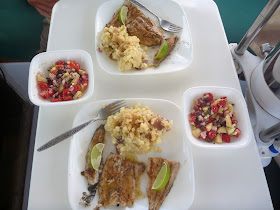Once we started spending more time aboard
Phoenix we began grappling with the age-old question: what's the best way to do laundry aboard? Of course, there are plenty of options, but we wanted something that would be in line with the way we live on board.
We spend very little time -- if any -- at marinas, and prefer to anchor out. We may anchor
near a marina, but typically only pull in to one to refuel or pump out the holding tanks, etc. We do have a generator on board; however, we prefer not to use it and would rather utilize the solar, wind and "green" energy for our daily living.
To fit our on board lifestyle, we needed a laundry solution that was simple, compact, that didn't draw a lot of power, and that didn't use up much water. We don't ask for much, do we? 😀
When we first began our refit, like everyone else, I was convinced that I wanted an electric washer/dryer. I loved the
Splendide washer/dryer combo units that we saw on the new boats at the Boat Show, but the more we looked into them, the more disenchanted we became and found the units had several drawbacks:
- The combo units weigh ~150 pounds,
- They can only dry about 1/2 - 3/4 of a washed load (the newest Splendide 2100XC can wash 15 lbs of clothes but only dry 11 lbs per load),
- They use between 7.5 and 16 gallons of water per load,
- Spin cycle is 1,200 rpm max,
- Wash cycles are between 40-80 minutes, drying cycles are between 90-110 minutes, so you either have to be plugged in at the dock or the generator would be running for several hours at a time for a single load
Frankly, we prefer the smell of line dried clothes over using the electric dryer anyway, so we started exploring compact front load washers instead. Those also had their shortcomings and required just as much water and power for a wash cycle as the Splendide.
We then strongly considered portable washers like the
Haier HLP21N. It weighs only 43 lbs, uses between 2-7 gallons of water per load, can be run off the inverter, and has wash cycles that run between 21-68 minutes. On the negative side, the spin cycle is only 700 rpm, so your clothes can be left relatively wet after a wash cycle.
On the opposite end of the spectrum, we tried hand washing everything and using a wringer to get both the dirty, soapy water and rinse water out of the laundry. This proved to be a royal pain in the butt since the wringers were labor intensive and it was difficult to get anything larger than a dish towel through them easily or effectively.
After looking at all of the options, we decided that
washing clothes isn't really the tricky part, and there isn't anything particularly magical about the wash cycles of the various machines on the market. They all simply agitate the clothes -- either by stirring them around or pulsing soap and water through them. The real trick is getting the dirt, soap and water
out of the clothes to get them truly clean (and to speed up drying time). The higher the rpm of the spin cycle, the cleaner your clothes will be since the centrifuge action removes the dirt, soap, and ultimately the water from your clothes.
With this in mind, we picked up a portable spin dryer that can spin at 3,200 rpm from
Laundry Alternative. It is small (14" diameter, 24" tall -- roughly the size of a typical kitchen garbage can), weighs only 22 lbs, easily runs off the inverter, holds 13 pounds of wet clothes (same as a standard capacity top load washer), and can remove a TON of water from your clothes in 2-3 minutes. Unfortunately it doesn't look like they make our exact model anymore, but
Panda makes a similar 3,200 rpm model with a slightly larger capacity that's available on Amazon.
 |
| Our 3,200 rmp spin dryer aboard Phoenix |
Paired with my trusty 5 gallon bucket and a plunger that Bill modified by drilling holes through the base to force and suck water through the clothes, we have a relatively easy laundry system that meets our needs!
 |
| A typical load of laundry washed and ready to go into the spin dryer before rinsing |
In the morning, we put our dirty clothes in the bucket with a small amount of laundry detergent, and used the plunger every now and then to agitate the clothes. The bucket easily fits in the corner of the cockpit, so we could agitate the clothes while underway if necessary. Later in the day, the wet, soapy clothes were loaded in the spinner and run for a minute or two to remove the dirt and water. Two rinses in the bucket (spinning between each rinse), and viola -- the clothes were clean, mostly dry and ready to hang on the line!
A typical load (1 bikini, 1 men's swim shorts, 3 shirts, 1 women's shorts, 3 dish towels) used 4.5 gallons of water. A load of towels (2 bath towels, 2 kitchen towels, 1 men's swim shorts, 2 hand towels) required a third rinse and used 6 gallons of water. After spinning at 3,200 rpm, the clothes dried in about 2 hours on the line, smelled wonderful and were nice and clean! Laundry day is no longer a chore and we don't have to listen to the generator and washing machine running for hours!
We may upgrade the plunger to a different handheld agitator like this
one down the road, but our semi-low tech solution works wonderfully for now!
 |
| Manual clothes agitator |






